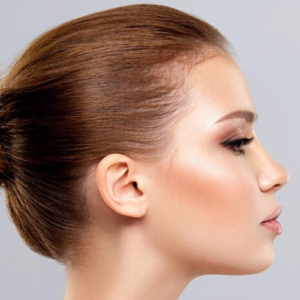Revision Rhinoplasty

What is Revision Rhinoplasty? Secondary Nose Surgery Explained
Revision rhinoplasty, also known as secondary rhinoplasty, is a specialized surgical procedure performed to correct or improve the results of a previous nose surgery. Whether due to aesthetic dissatisfaction, breathing difficulties, or complications from an earlier operation, revision rhinoplasty offers a second chance to achieve the desired nose shape and function. This advanced procedure requires high surgical precision, experience, and an individualized approach tailored to each patient’s unique needs.
In this detailed guide, we will explore what revision rhinoplasty involves, who is a good candidate, what to expect during surgery and recovery, and why it’s considered one of the most complex yet rewarding forms of nose surgery.
Why Do People Choose Revision Rhinoplasty?
While primary rhinoplasty successfully meets patient expectations in most cases, some individuals may need further correction. Revision rhinoplasty is typically chosen for one or more of the following reasons:
-
Unnatural or asymmetrical results from the first surgery
-
Functional problems, such as nasal obstruction or breathing issues
-
Over-reduction or under-correction of nasal bridge or tip
-
Collapsed nasal structure or poor cartilage support
-
Scar tissue or complications from previous rhinoplasty
-
Desire for aesthetic improvement after unsatisfactory healing
Each revision rhinoplasty case is unique, requiring personalized evaluation, surgical planning, and realistic goal-setting.
Who is a Candidate for Revision Rhinoplasty?
Good candidates for revision rhinoplasty are patients who:
-
Have undergone one or more previous nose surgeries
-
Are experiencing cosmetic dissatisfaction or breathing issues
-
Are in good overall health
-
Have realistic expectations about the outcome
-
Are emotionally prepared for the complexity of a secondary procedure
-
Are at least 12 months post-primary rhinoplasty, allowing sufficient time for healing and tissue stabilization
How is Revision Rhinoplasty Performed?
Revision nose surgery is typically more complex than the first procedure, due to scar tissue, altered anatomy, and limited availability of natural cartilage. The surgery may involve:
-
Open or closed techniques, depending on the required access
-
Cartilage grafting from the septum, ear, or rib for structural support
-
Scar tissue removal and reshaping of the nasal tip or bridge
-
Functional correction to improve breathing through the nasal airway
The procedure is usually performed under general anesthesia and can take 3 to 5 hours or longer, depending on complexity.
Common Techniques in Revision Rhinoplasty
Revision rhinoplasty involves a combination of advanced techniques, including:
Open Revision Rhinoplasty
Offers full visibility of the nasal structures, allowing for detailed reshaping and structural corrections. Often preferred for major revisions.
Closed Revision Rhinoplasty
Performed through internal incisions for minor adjustments. Offers faster healing with no external scars, but limited access.
Cartilage Grafting
Used to reconstruct damaged or over-resected areas. Cartilage may be harvested from the septum, ear, or rib, depending on need.
Piezo Ultrasonic Rhinoplasty (in select cases)
Uses ultrasonic vibrations to reshape nasal bones with high precision and minimal trauma, reducing swelling and improving healing.
How Long is Recovery After Revision Rhinoplasty?
Recovery from revision nose surgery follows a similar timeline to primary rhinoplasty but may take longer due to previous alterations and added complexity.
-
First week: Expect swelling, bruising, and use of nasal splints or external casts
-
2–4 weeks: Return to light daily activities; visible swelling begins to subside
-
3–6 months: Gradual improvement in nasal contour and function
-
6–12 months: Final results become apparent as all residual swelling resolves
Post-operative care includes avoiding glasses, protecting the nose from impact, using cold compresses, and following all surgeon instructions carefully.
Is Revision Rhinoplasty Worth It?
Yes—revision rhinoplasty can provide life-changing results when performed by an experienced facial plastic surgeon. It not only restores balance and harmony to the face but also corrects functional issues for improved breathing and comfort.
Patients should keep in mind that while the procedure is challenging, success is highly dependent on:
-
Surgeon experience and technique
-
Individual anatomy and skin type
-
Healing response and post-op care
-
Realistic expectations
Revision Rhinoplasty Costs: What Affects the Price?
The cost of revision rhinoplasty varies depending on:
-
Complexity of the procedure
-
Number of previous surgeries
-
Need for cartilage grafts or reconstruction
-
Surgeon expertise and qualifications
-
Location of the clinic or hospital
Because of its advanced nature, revision rhinoplasty costs are generally higher than primary nose surgery. A detailed consultation is essential to receive a personalized treatment plan and pricing.
Frequently Asked Questions
How Soon Can You Get Revision Rhinoplasty After a Previous Nose Surgery?
It’s recommended to wait at least 12 months after the initial rhinoplasty to allow the nose to fully heal and settle.
Is Revision Rhinoplasty More Painful Than the First Surgery?
Pain levels are typically manageable with medication. However, swelling and healing may take longer due to scar tissue.
Can Revision Rhinoplasty Fix Breathing Problems?
Yes, many patients choose revision surgery to correct functional issues, including nasal obstruction and valve collapse.
Are Results from Revision Rhinoplasty Permanent?
In most cases, results are long-lasting, but healing may vary based on skin type, age, and surgical complexity.
What if There’s Not Enough Cartilage Left in the Nose?
Cartilage can be harvested from the ear (auricular cartilage) or rib (costal cartilage) to reconstruct and support the nasal structure.

